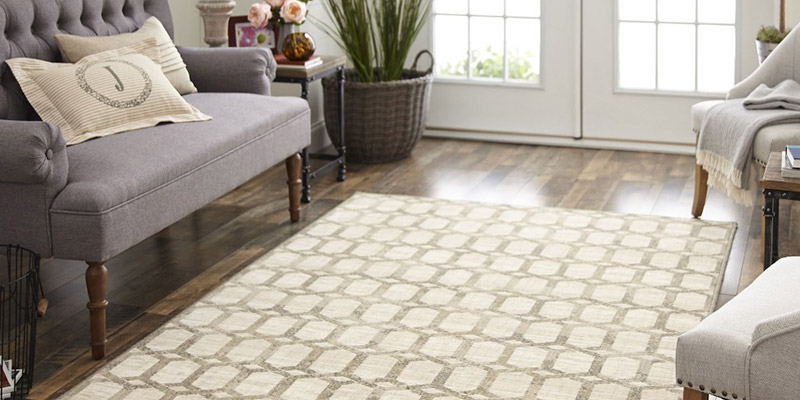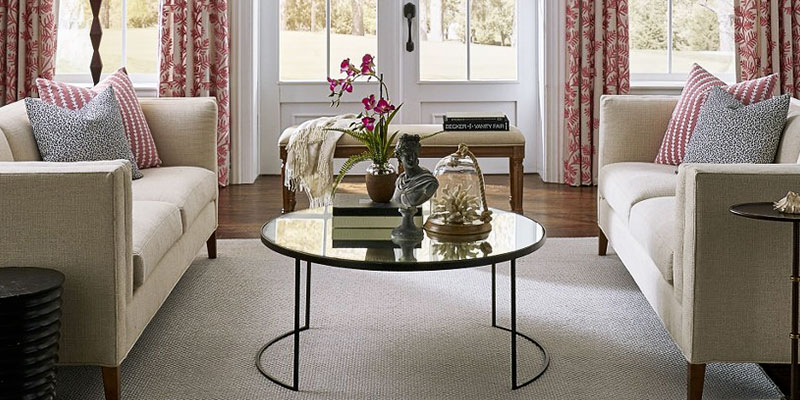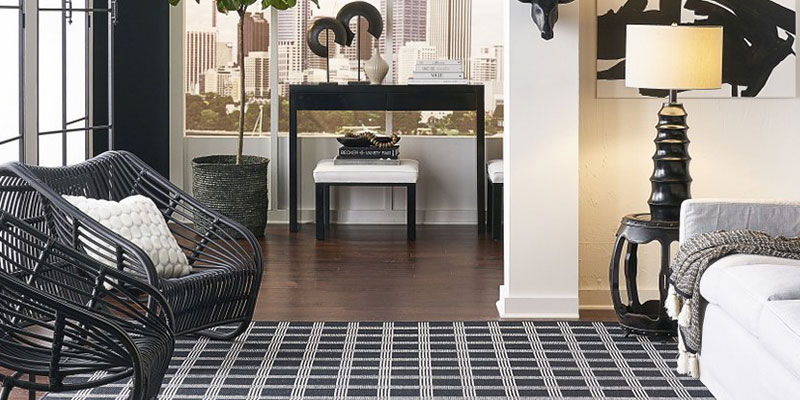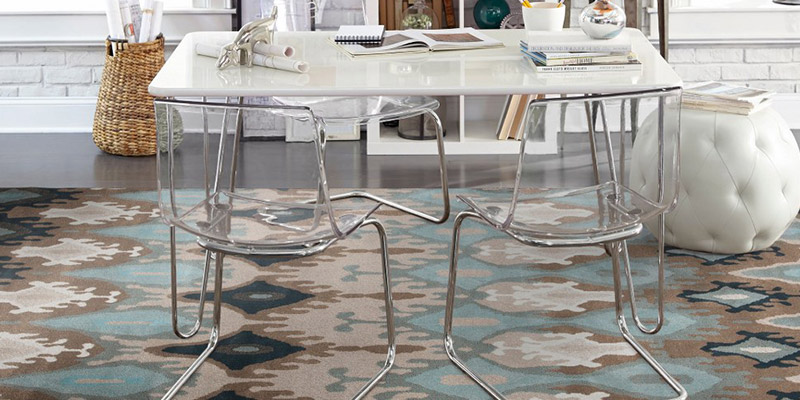Area rugs can be a game changer in a room! They can tie decor together or act as a complete statement piece. They can dampen sounds in rooms with high ceilings or add warmth to a cold tile floor. The icing on the design cake is that you can change out area rugs to give your room a new style whenever you want. They are really easy to work with and come in hundreds of different styles and colors! With all of that variation in mind, we’ve compiled some of our best tips for how to choose the right area rug for your space.

First, you’ll want to assess your living space for size and color considerations. Area rugs can pull all individual elements of a room together or add a touch of character with color and warmth. From a practical standpoint, these rugs can protect and even enhance the beauty of hardwood floors, or cover up flaws such as a stained carpet.
Whether your purchase is a long-term investment or a simple way to update your home's decor, knowing what you're looking for will help you decide. Consider material, size, durability, workmanship, extra enhancements, and overall style as essential steps in choosing your perfect area rug.
HomeClick’s Area Rug Buying Tips
- Purchasing an area rug should, first and foremost, be based on instinct. If you’re not drawn to a rug the same way you might be to a piece of art for your home, then it might not be the right choice for your space. A rug can say as much about you as any of the art or vignettes used to personalize your home. Buying a rug can allow you to add flare to a neutral furniture set-up or be the calm spot in a richly decorated room.
- Second, you’ll want to decide on the purpose of your rug. Do you need something to reduce noise in your space, add a pop of color, or are you looking to cover up that coffee that you accidentally spilled on Saturday morning? Armed with answers to these questions, moving onto the next steps will be easy. Now, it’s time to choose materials, size, and style.
Material World
Material choice affects the rug's longevity, stain-resisting properties and, most importantly, its look and feel. There are natural fiber options like wool, sisal and cotton as well as synthetic options. Carefully assess the texture of the rug to determine if the material is appropriate for low or high traffic spaces, your feet and your budget.
Natural Fibers
- Wool is generally regarded as the best choice of the natural fibers for durability and longevity, while other natural fibers are considered better than synthetic for the same reasons. High quality wool is durable, soft to the touch, and easy to clean, making it ideal for high traffic areas such as a hallway. Wool also holds dye better than the other natural fibers, which means a wool rug will be more fade resistant. Additionally, wool is resistant to dust mites and is recommended for allergy sufferers. Antique rugs made of wool demonstrate the inherent value of the material. The best Oriental and Persian rugs are made of wool, and, as expected for any object of high quality, are more expensive than rugs of other natural fibers.
- Silk is a second high quality, natural fiber choice and is a beautiful addition to any home. Bear in mind that silk is extremely delicate and must be treated as such. It is ideal for meeting aesthetic rather than functional needs.
- Cotton, like wool, is a soft fiber option, but it is less durable than wool. Buyers can find cotton rugs in a variety of styles, colors, shapes and textures. For more immediate decorating or functional needs, cotton is a great option, but if you would like to make a long-term investment with this purchase, wool is still reliable. Caring for a cotton rug is simple, as some are even machine-washable. A wool/cotton blend rug will have you reaping the benefits of wool's longevity with a smaller price tag and different texture.
- Sisal and sea grass are durable, firm natural fibers appropriate for rugs in high traffic areas. Providing a casual, earthy tone to your room, sisal and sea grass rugs generally have an element of subtlety, outlined by fabric borders. These types of fibers are less expensive than wool, but still offer a natural textile option.
- Jute rugs are generally soft, though they are available in a variety of textures. Less expensive than wool (and less durable), jute is still resilient and fairly long lasting, more so than cotton.

Synthetic Fibers
Synthetic fibers provide cheaper, stylistic options than natural fibers, but cannot match the longevity or overall quality of wool or cotton. Finding synthetic material rugs in your decided pattern or color may be easier than finding the same in natural fibers.
- Nylon, the most popular synthetic choice, is stain resistant and durable. It requires little overall maintenance and is appropriate for high traffic areas. Available in many styles and colors, nylon fibers mimic the look of wool, making it an ideal choice if you love the look, but can't swing the price of a wool rug.
- Acrylic and Polypropylene rugs are resistant to sunlight, stains and mildew and are great choices for areas of high humidity or overall moisture, like sun rooms.These materials are generally used for decorative, rather than functional, purposes.

Determining Size
Rug size should be a straightforward choice. If you are trying to highlight any part of the room, including the rug itself, a foot of floor space outside of the rug should be exposed. Of course, if a rug is meant for under a table, all four legs should rest with ease within the rug's borders. If the rug is to be used under a dining table, measure the tables' ends and add up to four feet to each, to accommodate the movement of the dining chairs. While room and rugs size will vary, 6' by 9' is a common choice. For accent rugs, 2' by 3' should suffice.
Style Central
Consider the rest of the room, your furniture style, the rug's function and budget when selecting a style. Fibers, colors and shapes are major contributing factors to a rug's overall style. If you are searching for something tastefully contemporary, a solid color cotton rug will suit your needs. If your style is formal, but not flashy, an antique oriental is appropriate. If you want to achieve a country style, a braided rug complements your space. Jute and sisal rugs reflect an earthy feeling, while intricate silk reflects a classy, delicate sentiment.
Review the decorating purpose of the rug. Know if you are trying to create a focal point or simple accent for the space, or if you are trying to define groupings of furniture. Making a bold statement with a colorful or patterned rug is tempting, but first assess the rug's function. If it will be hidden under a table or couch, perhaps uniform patterns and colors are best. If the rug will be a focal point, a more extravagant pattern or a medallion shape center will amplify its effect.
In choosing a style, don't abandon the practical reasons for your rug. Hiding food and drink spills under your dining room table is best achieved with a patterned rug, while protecting the floor in high traffic areas is best achieved with natural fiber, high durability rugs.
Because pattern, color and style choices can be overwhelming, we've outlined some common styles and types below:

Oriental and Persian Rugs
Oriental rugs, made in Asia, are primarily made of wool or silk. They have colorful and varied patterns and are generally flat-woven or hand-knotted, making the workmanship unparalleled. Persian rugs have similar workmanship qualities, but are traditionally manufactured in Iran. Persian and Oriental refer more to the design of the rug than the place of origin. The more intricate the design or pattern of these rugs, the more expensive they will be, as this translates to higher concentration of knots, and so, more work for the maker. Antique or handmade Oriental and Persian rugs are considered precious and must be bought from an experienced, well-reviewed dealer to ensure quality and authenticity.
Though beautiful in a way most rugs cannot purport to be, Oriental and Persian rugs are also a great practical choice. Patterns hide dirt or stains and accent rooms; high quality wool is durable and comfortable. Oriental and Persian rugs are meant to be both treasured and treaded upon.
Braided Rugs
Braiding a rug consists of weaving the rug's outermost strands over and under the inner strands, creating a traditional colonial appearance. As with other styles, wool is the highest quality material, but cotton and synthetic fibers are also popular choices. Braided rugs are versatile, welcoming, and sometimes reversible.
Shag Rugs
Once used to line staircases at disco clubs, shag rugs can now create a fun, stylish look with a soft, cozy feel. The highest quality are 100 percent wool, but mixing wool with synthetic fibers will significantly lower the price of the rug without a noticeable decrease in quality or soft texture.
Natural/Earthy Rugs
Jute, sisal, and seagrass rugs are casual and often sold without dye, since inherent imperfections add to their natural character appeal.
Handmade heaven
Workmanship influences the quality and the longevity of any rug. Handmade rugs are more valuable than their machine-made counterparts. Quality is indicated by knots per inch-- the higher the number, the more intricate and detailed the rug will be. High quality Oriental rugs may boast up to 1,000 knots per inch, but 100 to 300 knots per inch is fairly standard for most designs. Look for designs that are distinct, have defined edges and are formed with a tight and even weave. Cotton, wool and jute should always feel soft, while sisal and sea grass should feel firm and dense.
If you are buying an expensive rug, like a hand-knotted Persian, as an investment, seek out well-known, reputable dealers and brands. Ask if a Certificate of Authenticity is available, as it is important for insurance purposes and value appraisals.
Padding Your Purchase
A high quality rug pad will protect your floor from scratching and staining, increase the longevity of your rug and provide extra noise reduction and cushioning. Rug pads prevent the rug from slipping, either under your feet or your vacuum. Most rug retailers sell rug pads, so ask for one of a similar size and complementary material.
Price
There is no standard price for an area rug. They can range from $50 for a cotton 2' by 3' throw to tens of thousands for antique Orientals. Handmade, high quality wool rugs are the most expensive (in the $1,000 plus price range), while synthetic, machine made rugs are much cheaper. Better workmanship and materials and larger size will drive the price higher.

Bottom Line
Purchasing an area rug can add a significant style element to any room you choose. Sizing is simple, while choosing a style is more complicated, but function and aesthetics sometimes need to go hand-in-hand. Get to the heart of why you want the rug and then research designs and colors that both interest you and can achieve the purpose of the purchase. Beauty may be in the eye of the beholder, but discussing your options with a reputable dealer is always a sound decision.